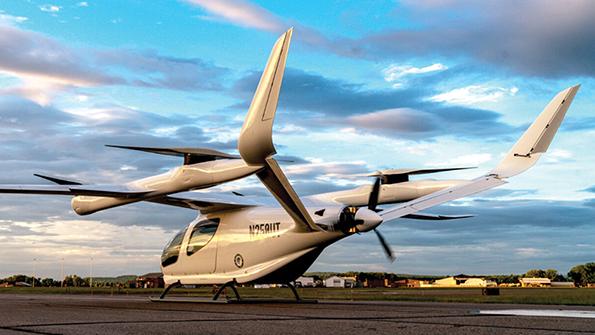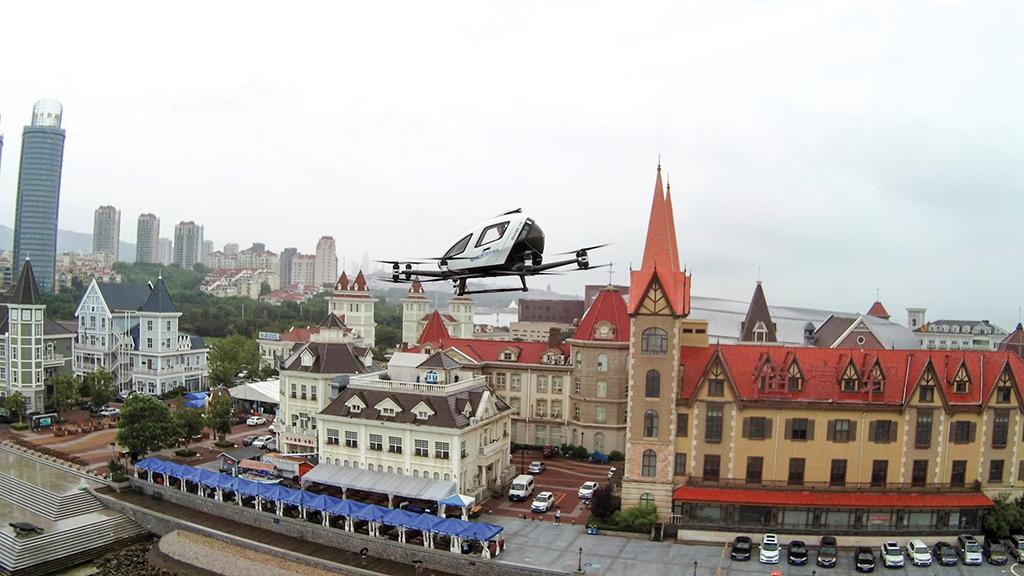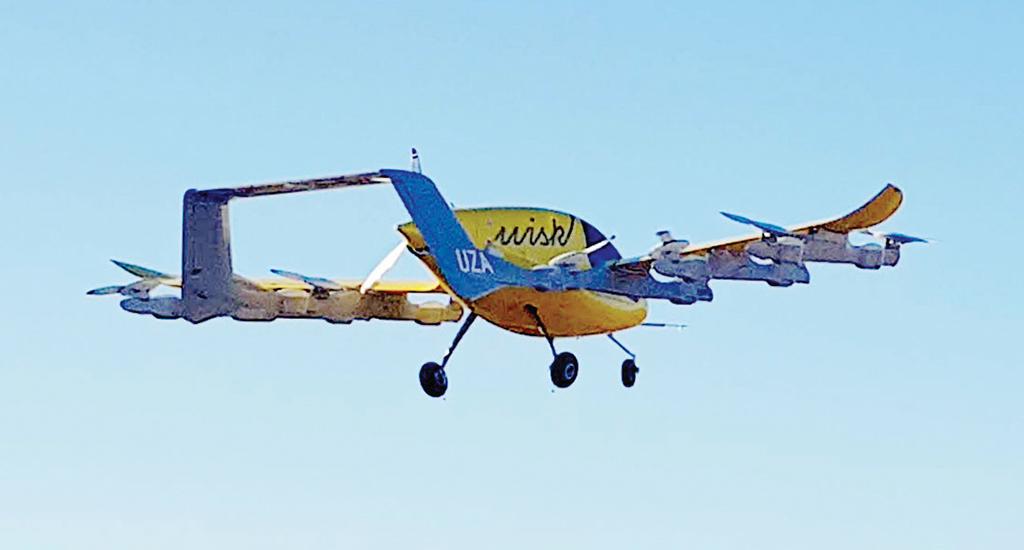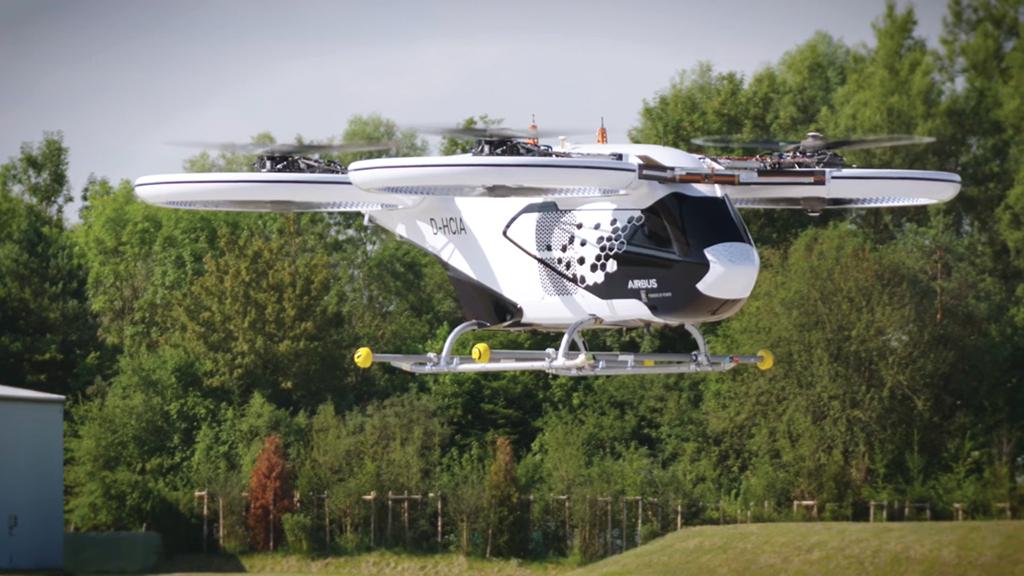eVTOLエアタクシーの認証取得に向けて加速するUAM先行者たち | UAM Leaders Accelerate Toward Certification Of eVTOL Air Taxis

機体は飛行試験に入り、認証/規制や空域のコンセプトは固まりつつあり、コミュニティの取り込みや教育も進んできたことで、都市型エアモビリティの実現が現実味を帯びてきた。
飛行試験の進展
新型コロナウィルスの感染拡大は、都市型エアモビリティの実現に冷や水を浴びせたことは確かだが、この分野に注がれている情熱を消し去ったわけではない。電動垂直離着陸(eVTOL)機の試験はペースが上がっており、今後3年以内には最初の型式証明と実用機のデリバリーが行われる可能性がある。
コロナ危機の影響で資金調達が困難になったため、業界はパンデミック発生時においても資金調達を成功させた「第1グループ」の先行者と、今も資金調達の道を探っているか、市場がどのように発展するかを見守っている「第2グループ」のフォロワーに分かれつつある。
彼らが試作機の開発から型式証明の申請に進んでいく中で、第1グループの企業は都市型エアモビリティ(UAM)の活動範囲を都市内に限定せず、より幅広いビジネスプランを検討している。都市間飛行・医療品の輸送・物流の無人化・救急サービス・軍事用途など、まさに生まれようとしている新たなマーケットの中にはこれら全てが含まれている。
また、マーケットそのものも変化している。今ではUAMはより幅広い「発展型エアモビリティ(AAM)」エコシステムを構成する一部分として捉えられるようになった。これはUAMと同じ技術を用いて、都市部・農村部・地域間における輸送を、電動推進の垂直離着陸機(eVTOL)・短距離離着陸機(eSTOL)・従来型離着陸機(eCTOL)により、有人/無人操縦を問わず進めていくというコンセプトだ。
7月には、eVTOL市場の先行者であるJoby Aviation社は、耐空証明取得のための試作機を、本社がある採石場跡(サンタクルーズの北西に位置するBonny Doon)から、サンフランシスコの南にあるFort Hunter Liggett にヘリで移送し、米陸軍基地上空にある制限空域を使用したより大規模な試験飛行が可能になった。
同社は、2023年までにこの完全電動ティルトプロップeVTOL機でFAAのPart 23認証を受けることを目指している。有人操縦されるこの機体は、現在のところ1回の充電で4人の乗客を乗せ、時速200マイル(320km/h)で150マイル(240km)飛行することができる。併せて、Joby社はFAA規則のPart 135に基づく、同機を用いた商用運航者となる予定だ。
また、NASAは2021年春にAAMナショナルキャンペーンの初期段階として、Joby社と共に飛行を行う予定だ。ナショナルキャンペーン開発試験イベントは、2022年に予定されている最初のキャンペーンであるNC-1に先立ち、カリフォルニア州にあるNASAのアームストロング飛行研究センターで実施される予定だ。
この一連のナショナルキャンペーンは、安全に商用運航を拡大していくための鍵となる、実際の運用シナリオに沿った形のデモンストレーションを行い、AAMの要件やシステム開発をサポートすることを目的としている。そのために、機体・空域サービスプロバイダ・空港関係者が一堂に会し、統合されたデモンストレーションを実施する。

Joby社は1月、トヨタ自動車が主導する5.9億ドルの資金調達ラウンドを発表し、調達総額は7.2億ドルに達した。その1ヶ月前には、Uber社の航空ライドシェア構想「Elevate」における航空機の運航を最初にコミットしたeVTOL機開発企業となっていた。
なお、Uber社は2023年に商用サービスの開始を計画していたが、コロナ禍の影響で6ヶ月程度の遅れが見込まれており、1つの都市で一定数の機体が活動する体制が整うのは2024年初頭になるだろう。これは、1社以上のeVTOL機開発企業の協力があって実現できるタイムラインだ。
6月には、Beta Technologies社の技術実証機がバーモント州バーリントンにある拠点から、チャンプレーン湖を越えてニューヨーク州のプラッツバーグ国際空港までヘリで移送され、湖およびかつての戦略空軍爆撃機基地の上空でより大規模な試験飛行を開始する。
Beta社の創業者・Kyle Clark氏は7月、地元ラジオ局のVermont Public Radio (VPR)に対し、「実際にこれらの機体の商業発注を受けているのは、業界内で当社だけだ」と語っている。同社はローンチカスタマーであるUnited Therapeutics社の出資を受け、移植用の臓器輸送を目的としたeVTOL機Aliaの開発を進める。
同社は現在、認証用の試作機の設計に入っている。機体重量6,000ポンドで、リフト・クルーズ方式を採用するAliaは、乗客2名と医療機器を搭載し、1回の充電で250海里(450km)を飛行することができる。Clark氏はVPRに対し、次なる用途は貨物輸送になると話している。Aliaには6名搭乗することができるが、エアタクシーとしての飛行はもっと先になるだろうと述べた。
5月には、Beta社とJoby社は米空軍のAgility Primeプログラムにおいて、第3段階である「initial capabilities opening」に進む、初のeVTOL機開発企業となった。同プログラムはFAA認証に向けた準備を加速させ、早い段階で国防総省における調達の可能性を探ることで、生産開始を支援することを目的としている。

第3段階においては、各社はフライトシミュレーターと試験データを提供し、空軍による機体性能の把握や、対応できるミッションの検討を支援する。そこから試作機および量産機の製造契約につながる可能性もある。Clark氏によると、シミュレーターを年内に、実機を2023年までに納入することが目標だという。
一方、ドイツではVolocopter社が先行試作機である2Xの飛行試験を続けており、量産機Volocityの認証を2022年末までにEU航空安全庁(EASA)から取得することを目指している。この機体重量1,985ポンドのマルチコプターeVTOL機は、2名の乗客を時速68マイル(109km/h)で、最大22マイル(35km)先まで輸送することができる。
当初は有人操縦されるこの機体は、1.44億ドルを調達したVolocopter社のブランドで運航される。同社は都市内のエアタクシー事業と空港シャトル事業から着手する予定で、すでにフランクフルト空港を運営するFraport社と、必要なインフラやオペレーションについて協議を進めている。
同じくドイツ国内のeVTOL開発企業であるLilium社も2025年から自社ブランドのサービス開始を計画しているが、別のマーケットを狙っている。Lilium社の目的は、離れた都市の中心部同士を結ぶ高速移動手段の確立だ。同社は都市内交通ではさほど移動時間の短縮は期待できず、バーティポート(垂直離着陸用飛行場)用地の確保も困難であると主張しており、CEOのDaniel Wiegand氏は「都市内での運用は望ましいものですらない」と述べている。
このような市場モデルを背景に、同社のLilium Jetには驚異的な性能目標を設定している。この5人乗りダクテッドファン式のeVTOL機は、300km/hで300kmの飛行が可能であり、なるべく距離の離れた都市を結び、時間短縮を実現するのに充分な性能を持っている。また同社は、インフラ整備に必要なコストは高速鉄道よりも1ケタ安いと主張している。
Wiegand氏は、目標としている航続距離300kmの電動推進機は最初の段階では達成できない可能性を認めているが、2~3年おきにバッテリー技術が進化し、テクノロジーが成熟していく中で、大幅な性能向上が実現できると考えている。 彼は「ビジネスモデルを成立させるためには、サービス開始段階で最低150~180kmの航続距離が必要になるが、これは簡単に上回ることができるだろう」と話す。
Lilium社は2機目のフルスケール技術実証機の飛行を準備している。1機目は2019年に飛行試験を開始したが、バッテリー交換中の地上火災で損傷した。量産機に近い形の認証用試作機の初飛行は2022年末から2023年初頭に予定されている。
第1グループに属する多くのeVTOL機メーカーは、認証プロセスを簡素化するために、少なくとも初期段階では有人操縦式のエアタクシーを開発している。しかし、そんな中でも2社は自律飛行機の開発を進めている。その1社は中国のEHang社で、量産機の製造を始める最初の会社でもある。ただし、この機体はまだ正式な認証を受けていない。
同社は5月に、中国民間航空局(CAAC)から無人航空輸送用の自律型無人機の商用試験運航を開始する認可を取得した。機体重量1,320ポンドのマルチコプターeVTOL機・EHang 216は、乗客2名またはペイロード440ポンドの搭載が可能だ。
広州を拠点とする同社は、観光分野において自律飛行するEHang 216を用いた旅客サービスのデモンストレーションも実施した。「次のステップは、旅客サービスに向けてCAACからより正式な認可を受けることだ」と語るのは、最高戦略責任者のEdward Xu氏だ。
同社は中国でeVTOL機を運用するためのロジスティクス・航空ツーリズム・エアータクシーや特殊目的(医療品輸送・消火作業など)マーケットの開発に取り組んでいるが、最初は国際的な無人物流システムに注力している。EHang社はすでにノルウェーおよびケベック州の顧客に対し、無人物流システム試験を行う許可を取得している。
ボーイング社とKitty Hawk社のジョイントベンチャーであるWisk社は、2人乗り自律型無人機Coraを用いた旅客輸送試験を計画しており、ニュージーランド民間航空局から承認を得るための作業を進めている。このeVTOL機は航空ツーリズム分野における商用定期便として運航する予定で、乗客が自律飛行する機体にどのように接するかを調査することが目的だ。
機体重量2,800ポンドのCoraの航続距離は、現在のところ25マイル(40km)強だ。この電動推進機は「部分的な自律飛行」が可能で、地上ステーションでパイロットがモニタリングする中、事前にプログラムされた経路を飛行することができると話すのは、CEOのGary Gysin氏だ。同社では、混雑したアメリカの都市部におけるサービス開始に向けて、衝突回避や飛行中のルート変更機能といった、より高次元の自律飛行能力の開発を進めている。高度な自律性が備われば、1人の地上オペレーターが複数のeVTOL機をモニタリングすることも可能になる。
最初の旅客便は同社のニュージーランド子会社により運航され、それは「非常に制限された環境、つまりニュージーランドのサウスアイランドにある遠隔地で、事前に設定された緊急着陸スポットを備えた、非常に緻密な経路で飛行することになる」とGysin氏は語り、これはアメリカの都市部で運航する日に向けて、赤ちゃんがハイハイの練習をしている段階だと説明した。
Wisk社は現在、同社として第5世代となるeVTOL機の設計を進めており、Coraがニュージーランドの耐空証明を取得するためのアップグレードも実施した。Gysin氏は「ニュージーランドの認証プロセスはアメリカとは異なるが、それは非常に厳しいものだ。そのため、認証を受けるためには社内業務の流れや必要書類の改善が必要になってきている。これはFAAから認証を受ける日に向けたステップにもなっているだろう」と述べた。
Coraは、Kitty Hawk社が進めていた3つのプロジェクトの内の1つとしてスタートした。なお、同社はGoogle社の共同創業者であるLarry Page氏と、Google社の自動運転車チームを率いたSebastian Thrun氏によって設立された。1つ目のプロジェクトは1人乗りの個人用航空機だ。同社は6月にこのプロジェクトを中止するまでに、この超軽量レクリエーション用eVTOL機を100機以上生産した。2つ目が、今ではWisk社に移管されたこのCoraだ。
そして3つ目が、現在飛行試験が進められている1人乗り高性能eVTOL機・Heavisideだ。個人移動用の飛行手段として開発されたこの機体は、前進翼およびカナード翼に8機のティルトローターを搭載する。同社は飛行試験用に約10機を製造し、Thrun氏によると最初は安全のために無人で飛行させるが、3年以内にFAA Part 23の型式証明を受けることを目指していると同氏は付け加えた。
以前のFlyerが限られた性能しか持たない、いわば「人間ドローン」だったのに対し、Heavisideは時速170~180マイル(約280km/h)で120マイル(192km)+10%を飛行することが可能で、巡航モードで高度1,200フィートを飛行する際の騒音レベルはわずか35dBであるとThrun氏は語る。また、電力消費量は時速120マイル(192km/h)での飛行中に1マイルあたり105Whであり、これは電気自動車のテスラ・モデル3が時速60マイル(96km/h)での走行時に1マイルあたり300Whを消費するのと比較して、極めて少ないことを付け加えた。
高速・高効率・飛行が簡単という特徴を持つHeavisideは、通勤手段・救急サービス・軍事用途といったマーケットを狙っている。Thrun氏は「私は、これがヘリコプターを置き換える新たな航空機になるというよりは、むしろ自動車の代わりになるものだと考えている。多くの企業は5人乗りの機体を開発しており、5人乗りにも実用性はあると思うが、我々は1人乗りの方がより汎用性が高いと考えている。しかし、これには議論の余地があるだろう」と話す。
マーケットが成長していくにつれて、第1グループの先行者達は生産計画を立て始めている。EHang社は量産を開始した2019年に61機のeVTOL機をデリバリーしたが、 2020年中頃の時点ではコロナ禍の影響もあり約20機に留まっているとXu氏は明かす。顧客の中には、空からの観光用途として20機のEHang 216を購入したホテルも含まれている。同社は広州近くの雲浮市にある工場を拡張し、2021年初頭には年間600機の生産体制を構築する。
Joby社はカリフォルニア州モントレー郊外にあるマリーナに製造・試験施設を建設しており、大きな出資を受けているトヨタ自動車が持つ製造・品質・コスト管理のノウハウを活用する計画だ。一方、Lilium社は追加の投資ラウンドで現在までに3.75億ドル以上を調達し、バイエルン州ウェスリングに連続生産のための工場を建設した。そして、Gysin氏によると現在飛行している7機のCoraはカリフォルニア州パロアルトで製造されたものだ。ただし、量産時にはよりコストがかからない場所、おそらく既存のボーイング社の施設で製造されることになるだろう。
これまで、eVTOLスタートアップ企業のほとんどは主要なシステムを自社開発してきたが、量産化に向けてより一般的なサプライチェーンが動き出す兆しが見えてきた。Lilium社は東レとカーボン複合材の供給契約を締結し、Volocopter社はドイツのDiehl Aerospace社からVoloCity用飛行制御コンピュータの供給を受ける。そして、Honeywell社に新設されたUAM事業部は、第1グループに属するeVTOL機には同社の装置が搭載されることを明らかにしている。
そんな中、主要航空機メーカーの多くは、UAMについては様子見の姿勢を取っている。Bell社やEmbraerX社のeVTOLデモンストレーターはまだ飛行していない。エアバス社は試験機を飛行させているが、ヒュンダイ自動車などと同様、2028~2030年頃に運航開始されるであろう第2グループとしての参入を検討している。
AirFinance社の創業者兼CEO・Kirsten Bartok Touw氏は「彼らは様子見の構えだ。資金力がある独立系企業が先行し、ミスを犯しながらも道を切り開いていくのを待っている。そのすぐ後ろでタイミングをはかり、道が開けると同時に仕掛けるだろう」と話す。彼女は、Eclipse社を例に挙げた。同社は超軽量ジェット機の市場を開拓したがビジネス的には失敗し、その後セスナ社のサイテーション・マスタングがヒットする土台を作った。
関連法規の発展
メーカーが生産計画を練り上げる中で、各国の規制当局には認証申請が続々と届いている。しかし現在のところ、それらは同じように処理されているとはいえず、これがeVTOL業界にとっての懸念材料となっている。
中国では、CAACがSpecific Operations Risk Assessment (SORA)のフレームワークを用いて迅速に処理を進めている。これは総重量330ポンド以上の大型ドローン向けに、「無人機システムの規則に関する航空当局間会議(JARUS)」が策定したものだ。
このアプローチにより、EHang社が自社の自律飛行機を用いた、航空物流のための商用運航の承認を最初に受ける企業となった。この承認は、2019年2月にCAACが公布した無人航空機に関する暫定規則に基づき、SORAの枠組みに沿って行われた。
この承認は、EHang 216を用いて、台州市の地上・丘の頂上・海岸・島に点在する顧客の拠点間で貨物輸送を行う、航空物流の試験サービスを実施するためのものだ。なお同社としては、運用データを蓄積していく中で、他の拠点への輸送や中国国内における旅客サービスの運航にも拡大していきたいと考えている。
一方、ヨーロッパにおいては、2019年7月にEASAが「VTOL機の特別条件(SC-VTOL)」と呼ばれる認証フレームワークを公表した。これにより、3基以上の推進装置を持つ小型VTOL機向けの新たなカテゴリーが設定された。これに続いて2020年1月には「電気および電気ハイブリッド推進システムの特別条件」案が発表され、6月には意見募集が締め切られた。さらに5月には、3つ目のピースとして、SC-VTOLに関する最初のMOC(Means of Compliance)案を発表した。
EASAによると、このMOC案は構造設計エンベロープ・飛行負荷条件・衝突安全性・バードストライク発生後の特性・フライバイワイヤシステムの設計・安全性評価プロセス・雷保護・最低ハンドリング特性評価といった、認証に必要な要求項目の主要部分を網羅している。

Lilium社とVolocopter社は、ともに自社のeVTOL機をSC-VTOLの枠組みを使って認証を受けようとしている。 これにより、商用運航を行うための「Enhanced」カテゴリーに認定されるが、これには民間貨物機と同様、致命的な故障の発生率を10-9以下に抑える必要がある。
アメリカの場合、FAAはeVTOL機の認証を行う際に既存の規則を用いつつ、特殊機能を持つ機体向けの特別条項を適用するというアプローチを採っており、多くの機体はPart 23 Amendment 64に基づき認証されている。これはゼネラルアビエーション向けの機体に関する規則を、機体性能の向上に合わせて改正したもので、業界によるコンセンサス基準を満たすことで、規則に適合しているとみなすものである。
FAAの無人航空機システム統合オフィスの責任者・Jay Merkle氏は1月に、少なくとも6機のeVTOL機が型式証明の取得に向けて順調に進んでいると語った。コロナ禍により飛行試験は中断されたが、複数のUAMスタートアップ企業はAviation Weekに対し、FAA担当者とリモート会議をするなどして、認証に向けたプロセスは進んでいると述べている。
最初の設計がPart 23の改訂版により耐空証明の取得に向けて進む中で、これらの機体を運航する上で障害となる規制がないか、FAAと業界は協力して調査している。これには、Part 91のような運航規則をどのように緩和すれば、自律飛行の拡大による運航や訓練の簡略化といった、業界にとってのアドバンテージにつながるのか、といった確認も含まれる。
機体の認証と飛行基準の策定は、FAA内でも別の事務局が所管しているため、行き違いが生じる可能性がある。「我々にとって最大の課題のひとつは、我々はあくまで航空機認証に関する“プロセス”の多くを管理しているにすぎないことだ」と話すのは、FAAにおける無人およびパイロットレス機技術部門のリーダーであるWes Ryan氏だ。
「我々は機体設計に用いられる新製品を認証することができ、飛行を容易にする技術の認証を支援することもできる。しかし、その技術を受け入れることや、空域に自律飛行機をいかに統合するかといった問題に関しては、まさにFAAが協力して解決しようとしているところだ。運航規則の見直しは、自動化が規則にどのような影響を与えるのかという疑問に答えるための最初の取り組みだ」と同氏は語る。
都市部のエアタクシーサービスは、まずは既存のヘリコプター航路と確立された手順を流用したフライトから始まると予想されている。しかし、eVTOL機の運用コストと運賃を自動車並みに引き下げるためには、自律飛行性能の向上と、空域管理システムの自動化が必要だ。
6月末にFAAは、NASAおよび業界と共同開発したUAM運用コンセプトの初期バージョン(UAM Concept of Operations:ConOps 1.0)を発表した。FAAは開発を3つのステージに分けている。まずは現行制度の下での飛行から始まり、続いてUAM専用航路を有人操縦で飛行するConOps 1.0運用に入り、そこから自律飛行と遠隔操縦による高密度運用にスケールアップしていく、というものだ。
最初の低密度のUAM運航は、ヘリコプターが使用している既存の規則とインフラを用いるが、そこから高密度運航に移っていく中で、FAAは有人操縦されるエアタクシーが機体性能に応じて設定されるUAM専用空域(コリドー)を飛行し、UAM発着場を結ぶようになると予想している。
UAMコリドー内では、各機はUAM専用の規則・手順・性能要求に従って飛行することになる。専用空域の下部、高度400フィート以下は無人交通管理(Unmanned Traffic Management:UTM)空域となり、それ以上の高度は既存の航空管制(Air Traffic Management:ATM)が管轄する。
コリドー内では、地域が策定しFAAが承認する規則に基づいた、協調的交通管理が行われる。運航者はUAM運航情報の取得および交換のために、サードパーティーの「UAMサービスプロバイダー(Providers of Services for UAM:PSU)」を利用する。
PSUは運航計画の作成・飛行目的の共有・戦略/戦術的な針路変更・空域管理・不測の事態への対処などをサポートする。彼らは、UTM空域をサポートする「無人航空機システムサービスサプライヤー(Unmanned aircraft system Service Supplier:USS)とも情報交換を行う。
ConOps 1.0は、以下のような3段階の自律化を定義している。
①「human-within-the-loop」:機内のパイロットが直接操縦
②「human-on-the-loop」:機内のパイロットによる監視制御および積極的なモニタリング
③「human-over-the-loop」:遠隔モニタリングおよび必要時の遠隔操縦
エンブラエル社のマーケットアクセラレーターであるEmbraerX社は、エンブラエル社が持つ航空管制の知見を活用し、都市部における航空交通管理(Urban Air Traffic Management:UATM)システムの開発に着手する。これにより、有人操縦機を音声で管制する現状と、高度に自律化される未来の橋渡しをすることが狙いだ。
UATMは空域設計に向けて現在のインフラの上に構築される手順ベースのアプローチだが、eVTOL機および航空交通管理ソフトフェア双方の発展に応じて進化することができる。これは都市部における航空交通を管理する中央集権的システムで、ATM・UTMサービスサプライヤーと情報を交換する。プロジェクトリーダーのDavid Rottblatt氏は「UATMはスケールアップに必要な手順とサービスを提供する」と話す。
UATMは、空域および手順の設計と、情報交換という2つの基本的な機能の上に構築されている。そして、飛行承認・フロー管理・動的な空域管理・適合性モニタリングという4つの運航関連機能を提供する。EmbraerX社は世界各地の複数の航空ナビゲーションサービス提供者と協力し、UATMのConOpsを各地の都市に適用できるようにする体制の構築を進めていると同氏は説明した。
エンブラエル社は自律化に関して進歩的なビジョンを持っている。「初期の商用運航では遠隔操縦機を用いるが、人口密度の低い遠隔地においては自律飛行の度合いを高める。これにより、我々はデータ収集を始めることができる」と語るのは、EmbraerX社の社長兼CEO・Daniel Moczydlower氏だ。
EHang社や、間もなくWisk社も着手することを念頭に、「このようなオペレーションはすでに始まっている。次の課題は自律飛行への移行だ。まだパイロットは搭乗し、システムの監視や操作も行うが、手順ベースのUATMが実現する高度に構造化されたオペレーションに従うことになる」と続ける。
「その次の進化では、パイロットが搭乗していなくても、高度に構造化されたオペレーションが確立されていることで、安全なデータ収集を続ける上で必要な確証と運航経験を担保することができる。これにより、いつでもどこでも自律飛行できる、つまり構造化されていないオペレーションが可能になる理想の未来に向けて、準備を進めることができる」と彼は話す。
社会による受け入れに向けて
認証取得のための飛行試験や生産計画の立案が進み、規制や空域利用の枠組みが形作られていく中、UAM業界は商用サービス開始に先立ち、地域コミュニティとの調整やインフラの確認に取りかかろうとしている。
Volocopter社は2022年にも運航開始を予定していることから、2019年9月にドイツ・シュトゥットガルトのメルセデスベンツ博物館において、自社のマルチコプターeVTOL機を用い、都市部における初の公開デモンストレーションを行った(ダイムラー社は出資者である)。2019年10月には、同社はイギリスのSkyports社とのコラボレーションにより、シンガポールのマリーナベイにある浮きドックでバーティポートのプロトタイプを披露した。

なお、Volocopter社は2017年にも、ドバイで試作機による無人デモフライトを行っている。1月には、ドバイ道路交通局が2022年に最初の商用エアタクシー運航を目指していることを明らかにした。そして7月には、同国はエアタクシーを含む無人機向けの仮想空域インフラを構築するSky Dome構想を支援する法整備を行った。
とはいえ、Lilium社は2025年以前の運航開始は想定していない。同社はモジュラー式のバーティポートのコンセプトを発表しており、これは小規模にスタートしつつも、マーケットの成熟に合わせてすぐにスケールアップできるものだ。また、7月には、同社はフロリダ州のタンパ・ベイ地域交通局に説明を行い、同局はこの地域をアメリカにおける試験エリアにするための協議を開始した。今後、世界中でこのような事例が見られることになるだろう。
ヨーロッパでは、ドイツのインゴルシュタットやフランスのトゥールーズなどがUAM試験エリアになるための取り組みを進めている。インゴルシュタットのマンヒング飛行場には軍の試験センターがあり、エアバス社は7月末にドナウワース工場でCityAirbus eVTOLデモンストレーターによる初の完全自律飛行を終えた後、ここでより大規模な飛行試験を行う予定になっている。
アメリカでは、非営利組織のCommunity Air Mobility Initiative(CAMI)が地元自治体への接触および教育を始めている。「都市部は10~20年先を見越した計画を立てており、UAMをメーカーが想定している時期に運航させるためには、自治体としては今すぐ都市交通計画に取り込む必要がある。 だからこそ、市民に受け入れてもらえるよう取り組むことが大切だ」とCAMIで共同エグゼクティブディレクターを務めるYolanka Wulff氏は語る。
このように、業界では順調に開発が進められているが、注意も必要だ。同氏は「一夜にして大きな変化が起こると考える人ほど抵抗感が強く、うまくいかないと考えがちな傾向がある。我々は、業界が敢えてゆっくりと着実なアプローチを採っていることを強調したい。市民に受け入れてもらうためには、これが重要だ」と締めくくった。
以上は、James Pozziが Aviation Week & Space Technologyいた記事です。Aviation Week Intelligence Network (AWIN) のメンバーシップにご登録いただくと、開発プログラムやフリートの情報、会社や連絡先データベースへのアクセスが可能になり、新たなビジネスの発見やマーケット動向を把握することができます。貴社向けにカスタマイズされた製品デモをリクエスト。
Vehicles are flying, certification regulations and airspace concepts are firming up, and communities are being engaged and educated as urban air mobility moves closer to reality.
Testing Vehicles
The coronavirus pandemic may have cooled the hype, but it has not dampened the enthusiasm in the nascent urban air mobility sector. Testing of electric vertical-takeoff-and-landing vehicles is picking up pace, and the first type certifications and commercial deliveries could come within the next three years.
Exacerbated by the COVID-19 crisis, which has made raising funding difficult in the resulting downturn, the industry has begun to differentiate into “first-wave” leaders that had their financing in place when the pandemic hit and “second-wave” followers still looking for funding or waiting to see how the market develops.
As they move through prototyping to certification, the first-wave companies are fleshing out business plans that are not all focused on inner-city urban air mobility (UAM). Intercity flights, medical deliveries, unmanned logistics, first responders and military missions are all in the emerging market mix.
And the market itself is changing. UAM is now viewed as just one part of a wider advanced air mobility (AAM) ecosystem that applies the same transformative technologies to urban, rural and regional transportation using electric vertical-, short- and conventional-takeoff-and-landing aircraft—eVTOL, eSTOL and eCTOL—manned and unmanned.
In July, eVTOL market leader Joby Aviation’s certification prototype was airlifted by helicopter from its headquarters in a disused quarry at Bonny Doon, northwest of Santa Cruz, to Fort Hunter Liggett south of San Francisco to enable expanded flight testing in the restricted airspace over the U.S. Army base.
The startup is working toward FAA Part 23 certification of its all-electric tiltprop eVTOL by 2023. The piloted aircraft is currently able to carry four passengers more than 150 mi. at 200 mph on a single charge. Joby will also be the commercial operator of its aircraft under FAA Part 135 regulations.
NASA plans to conduct flights with Joby in the spring of 2021 under the initial stage of its AAM National Campaign. The National Campaign-Development Testing event will be staged at NASA Armstrong Flight Research Center in California ahead of the first National Campaign, NC-1, planned for 2022.
The National Campaign series is intended to support development of AAM requirements and systems by bringing together vehicles, airspace service providers and airports through integrated demonstrations in operational scenarios that are key to safely scaling up commercial operations.

Joby in January announced a $590 million Series C funding round led by carmaker Toyota, taking the total raised to $720 million. A month earlier, it had become the first eVTOL vehicle developer to commit to operate aircraft in support of Uber’s Elevate aerial ride-sharing initiative.
Uber had planned to begin initial commercial service in 2023, but the novel coronavirus pandemic is believed to have forced about a six-month delay, with operation of a handful of vehicles in a single city now likely to begin early in 2024—a time frame supported by more than one eVTOL developer.
In June, Beta Technologies’ engineering prototype was airlifted by helicopter from its base in Burlington, Vermont, across Lake Champlain to Plattsburgh International Airport, New York, to begin expanded flight testing over the lake and the former Strategic Air Command bomber base.
“We’re actually the only company in the industry that has commercial orders for these aircraft,” Beta founder Kyle Clark told Vermont Public Radio (VPR) in July. The startup is being funded by launch customer United Therapeutics to develop its Alia eVTOL initially to deliver organs for transplants.
Beta is now designing the certification prototype. The 6,000-lb. lift-plus-cruise Alia is being designed to carry two people and a medical payload 250 nm on a single charge. The next mission will be cargo delivery, Clark told VPR. The Alia can seat six people, but air taxi flights are further off, he said.
In May, Beta and Joby became the first eVTOL developers to progress to the third stage of the U.S. Air Force Agility Prime program’s “initial capabilities opening.” Agility Prime is intended to help accelerate FAA certification and identify early Pentagon procurement opportunities to help launch production.

Under Phase 3, the companies will supply flight simulators and test data to help the Air Force determine the capabilities and potential missions for their eVTOLs. Contracts for prototypes and production aircraft could follow. Clark says the goal is to deliver the simulators this year and aircraft by 2023.
In Germany, Volocopter is continuing to flight-test its preseries prototype, the 2X, and plans to certify the production VoloCity with the European Union Aviation Safety Agency (EASA) toward the end of 2022. The 1,985-lb. multicopter eVTOL is designed to carry two people up to 22 mi. at 68 mph.
Piloted initially, the aircraft will be operated as a branded service by Volocopter, which has raised $144 million so far. The company is targeting inner-city air taxi and airport shuttle services initially and has been working with Frankfurt Airport operator Fraport on the infrastructure and operations required.
Fellow German eVTOL developer Lilium also plans to operate a branded service, beginning in 2025, but is targeting a different market. Lilium’s objective is to connect city centers with a high-speed network, arguing there is little opportunity for time-saving and little space for vertiports when operating within a city. “Inner-city operations are not even desirable,” says CEO Daniel Wiegand.
This market model has driven the company to set eyebrow-raising performance targets for its Lilium Jet ducted-fan eVTOL. The five-seat aircraft is designed to fly 300 km at 300 kph (185 mi. at 185 mph) so as to connect cities as far apart as possible and be fast enough to create that time gain. Lilium argues it can connect those cities at a fraction of the infrastructure cost of high-speed rail.
Wiegand concedes the all-electric aircraft may not achieve its 300-km-range target at the outset but expects battery upgrades every 2-3 years will deliver significant enhancements as technology matures. “We have to be at a minimum 150-180 km at entry into service to make the business case work, and we will easily beat that,” he says.
Lilium is preparing to fly a second full-scale technology demonstrator. The first was damaged in a ground fire during a battery exchange after beginning flying in 2019. First flight of the near-series-standard certification prototype is expected in late 2022 or early 2023.
While most first-wave eVTOL companies are developing air taxis that will be piloted, at least initially, to simplify regulatory approval, two of the leaders have taken the autonomous, self-piloted route. One, China’s EHang, is also the first to launch production, albeit without the formal seal of certification.
In May, EHang received approval from the Civil Aviation Administration of China (CAAC) to begin trial commercial operations of its autonomous air vehicles for unmanned air logistics. The 1,320-lb. EHang 216 multicopter eVTOL can carry a 440-lb. payload or two passengers.
The Guangzhou-based company also has conducted passenger-carrying demonstrations of the self-piloted EHang 216 in the aerial tourism application. “The next step is we are going to get to more formal approval from the CAAC for the passenger service,” says Edward Xu, chief strategy officer.
The startup is working to develop logistics, aerial tourism, air taxi and special mission markets such as medical delivery and firefighting for its eVTOLs in China, while initially focusing on unmanned logistics internationally. EHang has operating permits to conduct nonpassenger, unmanned logistics flight trials with customers in Norway and Quebec.
Wisk, the joint venture between Boeing and Kitty Hawk, is working to gain approval from the New Zealand Civil Aviation Authority to begin passenger-carrying trials with its two-seat self-piloted Cora. The eVTOL will be flown commercially on scheduled aerial tourism flights to understand how customers interact with a self-flying aircraft.
The 2,800-lb. Cora currently has a range of about 25 mi. plus reserves. The all-electric aircraft has “partial autonomy” and flies a preprogrammed route with a pilot in a ground control station monitoring the flight, says CEO Gary Gysin. Wisk is developing greater levels of autonomy, including collision avoidance and inflight rerouting, for when it begins urban services over a congested city in the U.S. Greater autonomy will allow multiple eVTOLs to be monitored by a single ground operator.
Initial passenger flights will be operated by Wisk’s New Zealand subsidiary in a “very contained environment, meaning we’re going fly in South Island, New Zealand, in a remote area, and it’s a very prescriptive flightpath, with predefined emergency landing spots,” says Gysin, describing this as the “crawl” phase of a crawl-walk-run approach leading to Wisk operating aircraft over U.S. cities.
Wisk is now on its fifth generation of eVTOL design and has upgraded the Cora to enable airworthiness certification in New Zealand. “Though New Zealand has a different certification process than the U.S., it’s very rigorous,” says Gysin. “It’s causing us to improve our internal business operations and all the documentation that we need to get certified. So it will be a step on the way to doing this with the FAA.”
The Cora began life as one of three projects at Kitty Hawk, a startup established by Google co-founder Larry Page and Sebastian Thrun, who led Google’s self-driving car team. The first was the Flyer single-seat personal air vehicle. Kitty Hawk built more than 100 of these ultralight recreational eVTOLs before terminating the program in June. The second was the Cora, now transferred to Wisk.
The third vehicle, now in flight-testing, is the Heaviside high-performance single-seat eVTOL. Intended for personal air transportation, this aircraft has eight tilting props on the foreplane and forward-swept wing. Kitty Hawk has built about 10 prototypes for flight testing, initially unmanned for safety, says Thrun, adding that the company is aiming for FAA Part 23 type certification in three years.
Where the Flyer was a low-performance “human drone,” Heaviside is designed to fly one person at 170-180 mph for 120 mi. plus 10% reserves, with a noise level of just 35 dB when flying at 1,200 ft. above ground level in cruise mode, says Thrun. Energy usage is 105 Wh/mi. at 120 mph, compared with 300 Wh/mi. for a Tesla Model 3 electric car at 60 mph, he notes.
Fast, efficient and easy to fly, the Heaviside is aimed at commuter, first responder and military markets. “I think of this not as a new aircraft that might replace helicopters, but as more of an alternative to cars,” says Thrun. “I know that many people are building five-seaters, and there’s utility to five-seaters. We believe that a single-seat[er] is going to be more versatile, but it’s an open debate.”
As the market evolves, the first-wave leaders are now making plans for production. EHang delivered 61 eVTOLs in 2019, its first year of production, but had only delivered “about 20” by mid-2020 because of disruption caused by COVID-19, Xu says. Customers include a hotel that purchased 20 EHang 216s for aerial sightseeing. EHang is expanding its facility at Yunfu near Guangzhou to increase production capacity to an initial 600 units a year beginning early in 2021.
Joby is building a manufacturing and testing facility in Marina, just outside Monterey, California, and plans to draw on major investor Toyota’s expertise in manufacturing, quality and cost control. Lilium, which has so far raised more than $375 million through incremental funding rounds, has built its serial-production plant in Wessling, Bavaria. Gysin says the seven Coras now flying were built in Palo Alto, California. But production will be in a lower-cost location, likely an existing Boeing facility.
Until now, most of the eVTOL startups have developed the key systems internally, but as they look to volume production there are signs of a more conventional supply chain emerging. Lilium has signed an agreement with Toray for the supply of carbon-fiber composite material. Volocopter has tapped Germany’s Diehl Aerospace to provide the flight control computers for the VoloCity. And Honeywell’s new UAM business unit says it will have equipment on the first wave of eVTOLs to enter service.
Most of the major aircraft manufacturers, meanwhile, are taking a wait-and-see attitude to UAM. Bell and EmbraerX have yet to fly their eVTOL demonstrators. Airbus has flown testbeds but, like automaker Hyundai, is looking at being part of the second wave of vehicles entering service in 2028-30.
“They are taking a wait-and-see approach,” says Kirsten Bartok Touw, founder and CEO of AirFinance. “They are waiting for the first-movers, the independent companies with access to capital, to make the mistakes and pave the pathway, and then they’re going to be just behind them and ready to go once they see that path clear.” She cites the example of Eclipse, the startup that pioneered the very light jet market then failed but paved the way for the Cessna Citation Mustang.
Advancing Regulations
As manufacturers lay their production plans, regulators are getting their certification ducks in a row. But so far, they are not all lined up in the same harmonized row, which is a concern for the eVTOL industry.
In China, the CAAC has moved out quickly with an approach based on the Specific Operations Risk Assessment (SORA) framework developed for large drones, above 330-lb. gross weight, by the multinational Joint Authorities for Rulemaking on Unmanned Systems.
It is under this approach that EHang has received the first approval to pilot commercial operations of its autonomous air vehicles, initially for aerial logistics. The approval was granted based on interim rules for unmanned aircraft promulgated by the CAAC in February 2019 and based on the SORA framework.
The approval is for a trial air logistics service using the EHang 216 to transport cargo between the ground and a hilltop and the shore and islands at a customer site in Taizhou. But it is intended to be expanded to other sites and to passenger flights in China as EHang accumulates operational data.
In Europe, meanwhile, EASA published its Special Condition for VTOL (SC-VTOL) certification framework in July 2019. This established a new category for small VTOL aircraft with three or more lift/thrust units. This was followed in January 2020 with the proposed Special Condition for Electric and Hybrid-Electric Propulsion Systems, which closed for comment in June. The third building block was placed in May, when EASA released for consultation the first proposed means of compliance (MOC) with SC-VTOL.
The proposed MOC cover key certification requirements such as the structural design envelope, flight load conditions, crashworthiness, capability after bird impact, design of fly-by-wire systems, safety assessment process, lightning protection and minimum handling-qualities rating, according to EASA.

Lilium and Volocopter are both working to certify their eVTOLs under SC-VTOL, which establishes an Enhanced category for commercial operations that requires the same 10-9 probability of catastrophic failure as commercial transport aircraft.
In the U.S., the FAA is taking the approach of certifying eVTOLs under existing regulations with special conditions for unique features. The majority of vehicles are being certified under Part 23 Amendment 64, the performance-based revamp of the rules governing general-aviation aircraft that allows the use of industry consensus standards as the means of compliance.
At least six eVTOL aircraft are well along in type certification, Jay Merkle, head of the FAA’s Unmanned Aircraft Systems Integration Office, said in January. COVID-19 halted flight-testing, but several UAM startups tell Aviation Week they have been able to continue to make progress with certification via virtual meetings with FAA officials.
As the first designs go through revamped standards-based Part 23 airworthiness certification, the FAA and industry are working together to identify other regulatory barriers to operating these aircraft. This includes looking at how operating rules such as Part 91 could be made less prescriptive, allowing the industry to take advantage of increases in autonomy that simplify vehicle operations and training.
The aircraft certification and flight standards services are different offices within the FAA, which can lead to a disconnect when it comes to a standards-based approach to certification. “One of our biggest challenges is we only control so much of the process on aircraft certification,” says Wes Ryan, unmanned and pilotless aircraft technology lead at the FAA.
“We can certify new products on the design of the aircraft, and we can help certify technology that will make the aircraft easier to fly,” he says. “The acceptability of that technology and how that automation integrates into the airspace is really something the FAA is working on in collaboration to solve, and the review of the operational rules is one of the first forays into the question of the impact of automation on the rules.”
Urban air taxi services are expected to begin with flights on established helicopter routes using existing procedures. But scaling operations to volumes that will bring eVTOL costs and ticket prices down to levels that can compete with cars will require increasing autonomy in the vehicle and automation in the airspace management system.
In late June, the FAA released the first version of its UAM Concept of Operations (ConOps 1.0), developed with NASA and industry. The agency foresees three stages of development beginning with flights under current rules, progressing to ConOps 1.0 operations with piloted vehicles in UAM corridors, and scaling to mature high-density operations with automated vehicles and remote operators.
Initial low-tempo UAM services will use existing rules and infrastructure for helicopter operations. But as the tempo increases the FAA foresees piloted air taxis flying between specific UAM aerodromes via dedicated corridors of performance-based airspace.
Within these corridors, vehicles will operate under UAM-specific rules, procedures and performance requirements. Below the corridor, under 400 ft., will be unmanned traffic management (UTM) airspace, and above that will be airspace that comes under existing air traffic management (ATM) rules.
Within the UAM corridors, cooperative traffic management will be based on rules developed by the community and approved by the FAA. Third-party “providers of services for UAM,” or PSUs, will be used by operators to receive and exchange information during UAM operations.
PSUs will support operations planning, flight intent-sharing, strategic and tactical deconfliction, airspace management and off-nominal operations. These service providers will exchange information with the unmanned aircraft system service suppliers, or USS, supporting UTM airspace.
ConOps 1.0 lays out three levels of automation: human-within-the-loop, with an onboard pilot in direct control; human-on-the-loop, with supervisory control and active monitoring; and human-over-the-loop, with passive monitoring by a remote operator who is engaged when required by the automation.
EmbraerX, the market accelerator within Embraer, has tapped into the Brazilian manufacturer’s air traffic control expertise to develop an urban air traffic management (UATM) construct that would bridge the gap between today’s piloted voice-based airspace management and a highly autonomous future.
UATM is a procedures-based approach toward airspace design that is built on today’s infrastructure, but has the ability to evolve as both eVTOLs and air traffic management software advance. It is a centralized system for managing urban air traffic that exchanges information with ATM and UTM service suppliers. “UATM provides the procedures and services required to scale,” says project leader David Rottblatt.
UATM is built on two foundational services: airspace and procedure design and information exchange. And it provides four operational services: flight authorization, flow management, dynamic airspace management and conformance monitoring. EmbraerX is now collaborating with multiple air navigation service providers globally to tailor the UATM conops to different cities, Rottblatt says.
Embraer also has an evolutionary vision for autonomy. “We envision early commercial operations will involve remotely piloted aircraft, with an increasing level of autonomy but operating in more remote regions with not a lot of density of population. This would allow us to start gathering data,” says Daniel Moczydlower, president and CEO of EmbraerX.
“This type of operation has already started,” he says, a reference to EHang and soon Wisk. “The next challenge would be to move to an autonomous solution—still with the pilot on board, monitoring and interacting with the system—but constrained to a highly structured operation” of the type enabled by the procedures-based UATM.
“In the next evolution, there would be no pilot on board, but still the highly structured operation would be there to ensure the level of confidence and operational experience that is needed to safely keep collecting data so we can prepare ourselves for the challenges ahead, which would be less-structured operations and, in the future, the holy grail of fully autonomous anytime, anywhere,” Moczydlower says.
Gaining Acceptance
With certification testing and production planning underway and regulations and airspace taking shape, the UAM industry is looking to engage with communities and identify infrastructure ahead of launching commercial service.
With plans to begin flights as early as 2022, Volocopter conducted the first urban public demonstrations of its multicopter eVTOL in September 2019 at the Mercedes-Benz Museum in Stuttgart, Germany (Daimler is an investor). In October 2019, the startup cooperated with UK company Skyports to showcase a prototype vertiport on a floating dock in Singapore’s Marina Bay.

Volocopter conducted unmanned demos of its prototype in Dubai in 2017. In January, the Dubai Roads and Transport Authority said it was targeting 2022 for the first commercial air taxi operation. And in July the emirate issued legislation supporting the Sky Dome initiative to create a virtual airspace infrastructure for unmanned aircraft, including air taxis.
Although Lilium does not plan to start operations until 2025, it has revealed a modular vertiport concept that could start small but scale up quickly as the market takes off. In an event likely being repeated around the world, the startup in July briefed the Tampa Bay Area Regional Transit Authority in Florida, which voted to begin talks to become a U.S. test site.
In Europe, cities such as Ingolstadt in Germany and Toulouse in France have initiatives to become UAM test sites. Ingolstadt Manching Airfield hosts a military test center where Airbus will conduct envelope expansion for its CityAirbus eVTOL demonstrator after completing the first fully autonomous flight at its Donauworth plant at the end of July.
In the U.S., the nonprofit Community Air Mobility Initiative (CAMI) has begun engaging and educating local agencies. “Metropolitan areas have a 10-20-year planning window, and for UAM to roll out in the time frame many of the manufacturers are talking about, cities have to be incorporating it into their transportation plans now. That is why it’s so important we address public acceptance,” says Yolanka Wulff, CAMI co-executive director.
Despite the industry’s clear progress, caution is required. “Folks who think this is going from zero to 60 overnight tend to both be much more resistant to it and more convinced it simply won’t work,” says Anna Dietrich, CAMI co-executive director. “We like to emphasize the industry is taking a crawl, walk, run approach to UAM, and that will be important for public acceptance.”


